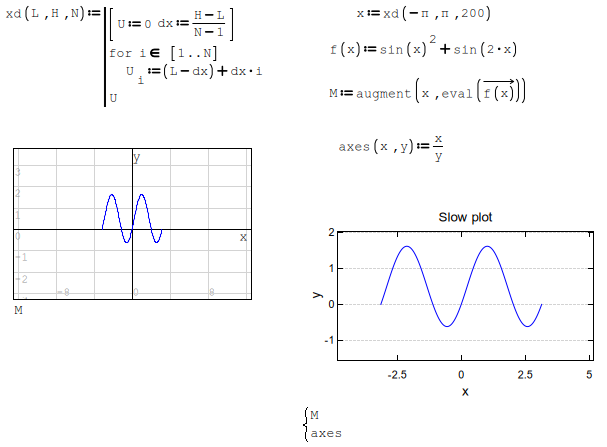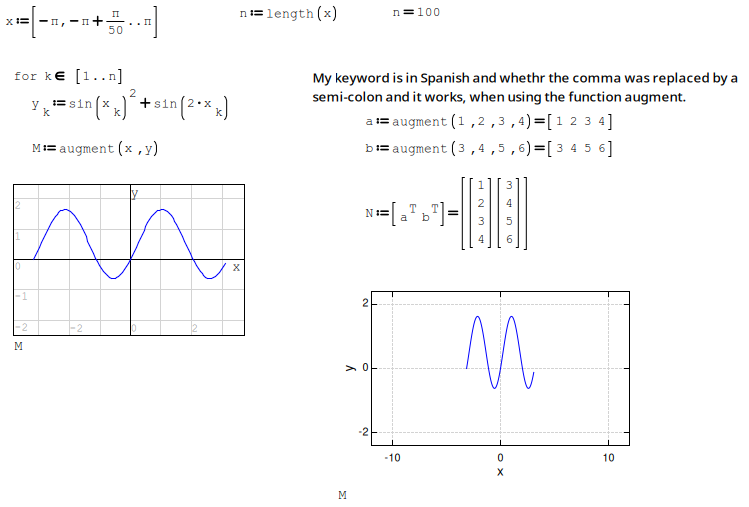1 Pages (15 items)
Basic Graphics - The augment function maybe not working on Linux - Messages
#1 Posted: 3/29/2023 2:41:21 PM
Hi,
I installed Smath Studio from the AUR repository, I am using Arch and the installation went fine.
I am reading the document GraficasBasicas2012.pdf, which I downloaded from the Wiki Tutorials.
The problem is that the function augment(1,2,3) works different under Linux, and I cannot figure out how to make a simple graphic as the one in the adjointed file.
graficos_prueba.sm (9.46 KiB) downloaded 836 time(s).
Maybe someone could help me, regards.
I installed Smath Studio from the AUR repository, I am using Arch and the installation went fine.
I am reading the document GraficasBasicas2012.pdf, which I downloaded from the Wiki Tutorials.
The problem is that the function augment(1,2,3) works different under Linux, and I cannot figure out how to make a simple graphic as the one in the adjointed file.
graficos_prueba.sm (9.46 KiB) downloaded 836 time(s).
Maybe someone could help me, regards.
#2 Posted: 3/29/2023 3:59:11 PM
Hi,
In the Tools->Options Section I could change the semicolon <;> and now I use the comma (,) as separator. Now I can use the function augment with comma (,) but the graphic function is still not working.
I wonder whether someone can give me a hint.
Regards,
In the Tools->Options Section I could change the semicolon <;> and now I use the comma (,) as separator. Now I can use the function augment with comma (,) but the graphic function is still not working.
I wonder whether someone can give me a hint.
Regards,
#3 Posted: 3/30/2023 8:09:11 AM
#4 Posted: 3/30/2023 10:21:48 AM
#5 Posted: 3/30/2023 11:34:39 AM
WroteHi Jean,
Tank you for the post, he problem was solved using the palette.
I will mark as solved.
NO Javier, NOT solved.
Your 'x' is improperly meshed.
#6 Posted: 3/30/2023 12:16:30 PM
Hi Jean,
I can reproduce your example without any problem, I cannot understand where the parameters H,N and L are defined. Also, you defined a function xd and used to evaluate x. Why I cannot use range?.
I suppose that is there an useful explanation for this, which I am curious about it. Maybe, you can give me some hint?

Regards,
I can reproduce your example without any problem, I cannot understand where the parameters H,N and L are defined. Also, you defined a function xd and used to evaluate x. Why I cannot use range?.
I suppose that is there an useful explanation for this, which I am curious about it. Maybe, you can give me some hint?

Regards,
#7 Posted: 3/30/2023 1:09:12 PM
WroteHi Jean,
I can reproduce your example without any problem, I cannot understand where the parameters H,N and L are defined. Also, you defined a function xd and used to evaluate x. Why I cannot use range?.
I suppose that is there an useful explanation for this, which I am curious about it. Maybe, you can give me some hint?
[L,H,N] are defined in x:= xd(L,H,N)
Why I cannot use range ?.
If you use range, 'x' will start -pi
but will never exactly terminate +pi
unless N in range is 15 decimals ... totally foolish.
Your graph does not terminate +pi.
xd discretizer will populate exactly any 'N' ± pi.
Cheers ... Jean.
#8 Posted: 3/30/2023 3:28:21 PM
#9 Posted: 3/30/2023 4:22:54 PM
Hi Jean,
I am greatly surprised with your answer.
I will take care of this lesson in future calculations.
Thanks in advance,
I am greatly surprised with your answer.
I will take care of this lesson in future calculations.
Thanks in advance,
#10 Posted: 3/30/2023 9:49:26 PM
If your purpose is plotting a range, this is the way.
This is most suitable for your type of functions.
No mumbo jumbo, no algorithm, no unnecessary coding.
Only pure simple if block.
Regards

graficos_prueba1.sm (11.05 KiB) downloaded 822 time(s).
This is most suitable for your type of functions.
No mumbo jumbo, no algorithm, no unnecessary coding.
Only pure simple if block.
Regards

graficos_prueba1.sm (11.05 KiB) downloaded 822 time(s).
1 users liked this post
sergio 3/31/2023 10:20:00 AM
#11 Posted: 3/31/2023 9:40:31 AM
Hi Overlord,
I very appreciate your thoughts, the graphics looks pretty good.
Kind regards
I very appreciate your thoughts, the graphics looks pretty good.
Kind regards
#12 Posted: 3/31/2023 10:55:57 AM
WroteHi Jean,
I am greatly surprised with your answer.
I will take care of this lesson in future calculations.
Thanks in advance,
The all thing is to complete a project, mostly export.
See the missing regions ...
Please, don't hesitate ... Jean.
Javier More.sm (9.5 KiB) downloaded 852 time(s).
#13 Posted: 3/31/2023 11:05:02 AM
Hi Jean,
This file is showing the origin of some missing parameters, like H,L,N, thank you for this worksheet.
I have a BSc in chemical engineering and a PhD in Industrial Chemistry, I also work in a biotechnology institute since 2003.
Maybe, this is why I was asking so many questions.
Kind regards,
This file is showing the origin of some missing parameters, like H,L,N, thank you for this worksheet.
I have a BSc in chemical engineering and a PhD in Industrial Chemistry, I also work in a biotechnology institute since 2003.
Maybe, this is why I was asking so many questions.
Kind regards,
#14 Posted: 3/31/2023 8:27:42 PM
#15 Posted: 4/1/2023 10:20:34 AM
WroteThis file is showing the origin of some missing parameters, like H,L,N, thank you for this worksheet.
To fully understand the command line algorithmic construction,
revisit this 4 examples document. Cheers ... Jean
Solve(f,q,x0,x1,TOL).sm (54.65 KiB) downloaded 800 time(s).
1 Pages (15 items)
- New Posts
- No New Posts

